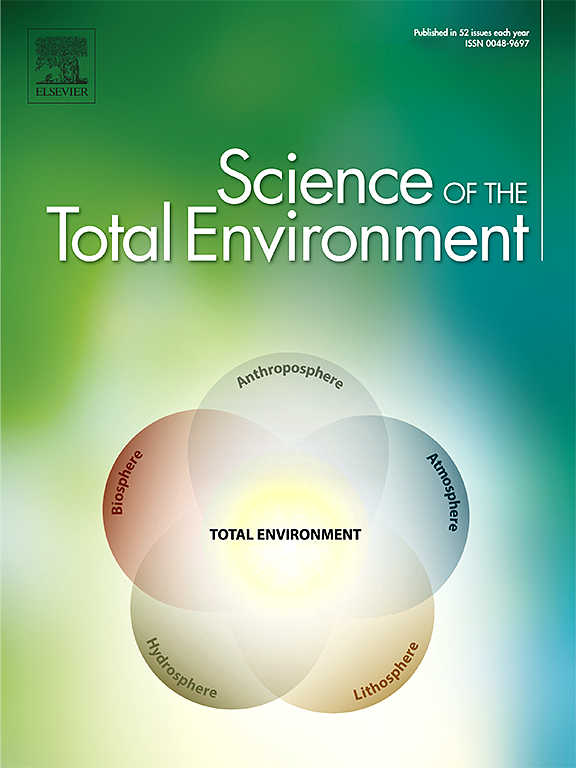Enhancing evapotranspiration estimates in composite terrain through the integration of satellite remote sensing and eddy covariance measurements
IF 8.2
1区 环境科学与生态学
Q1 ENVIRONMENTAL SCIENCES
引用次数: 0
Abstract
Accurate evaluation of water resource systems is essential for informed planning and decision-making. Evapotranspiration (ET), a key component of water resource management, is often estimated using remote sensing techniques; however, such estimates can be subject to significant uncertainties under certain conditions. In this study, we present a novel approach to improving the accuracy of ET estimates in composite terrains. The methodology involves optimizing the Surface Energy Balance Algorithm for Land (SEBAL-OPT) by integrating ground-based eddy covariance (EC) flux tower data into the satellite-based ET retrieval process. The approach was evaluated at four sites in California, each representing different land uses. Parameter optimization was achieved through Bayesian inference using the Differential Evolution Adaptive Metropolis (DREAM) algorithm, which minimized discrepancies between ET estimates derived from Landsat 8 and 9 imagery and the observed ET from EC measurements. Results from the global sensitivity analysis identified solar radiation and hot/cold pixel selection as the most sensitive parameters in the SEBAL algorithm, highlighting their critical role in reducing uncertainty in ET estimates. SEBAL-OPT demonstrated significantly improved accuracy, with root mean square error (RMSE) values ranging from 0.72 mm to 1.33 mm, compared to the original SEBAL parameterization (SEBAL-ORG), which produced RMSE values between 1.03 mm and 2.14 mm. This approach highlights that, when properly calibrated, the model can be effectively applied across diverse agricultural landscapes, regardless of the specific land use at individual sites. These findings have significant implications for water resource planning, agricultural water management, and water rights adjudication and could be applied to other remote sensing of ET models.

通过卫星遥感和涡动相关测量相结合提高复合地形蒸散发估算。
水资源系统的准确评价对于明智的规划和决策至关重要。蒸散发(ET)是水资源管理的一个关键组成部分,通常使用遥感技术进行估算;然而,在某些条件下,这种估计可能存在很大的不确定性。在这项研究中,我们提出了一种新的方法来提高复合地形的ET估算精度。该方法包括通过将地面涡动相关(EC)通量塔数据整合到基于卫星的ET检索过程中,优化陆地表面能量平衡算法(SEBAL-OPT)。该方法在加州的四个地点进行了评估,每个地点代表不同的土地用途。采用差分进化自适应大都市(DREAM)算法通过贝叶斯推理实现参数优化,该算法最小化了Landsat 8和9图像估算的ET与EC测量观测到的ET之间的差异。全局敏感性分析结果表明,太阳辐射和热/冷像元选择是SEBAL算法中最敏感的参数,突出了它们在减少ET估计不确定性方面的关键作用。与原始SEBAL参数化(SEBAL- org)产生的均方根误差(RMSE)值在1.03 mm至2.14 mm之间相比,SEBAL- opt显示出显着提高的精度,其均方根误差(RMSE)值在0.72 mm至1.33 mm之间。这种方法强调,如果经过适当校准,该模型可以有效地应用于不同的农业景观,而不考虑个别地点的具体土地利用情况。这些发现对水资源规划、农业用水管理和水权裁决具有重要意义,并可应用于其他遥感ET模型。
本文章由计算机程序翻译,如有差异,请以英文原文为准。
求助全文
约1分钟内获得全文
求助全文
来源期刊

Science of the Total Environment
环境科学-环境科学
CiteScore
17.60
自引率
10.20%
发文量
8726
审稿时长
2.4 months
期刊介绍:
The Science of the Total Environment is an international journal dedicated to scientific research on the environment and its interaction with humanity. It covers a wide range of disciplines and seeks to publish innovative, hypothesis-driven, and impactful research that explores the entire environment, including the atmosphere, lithosphere, hydrosphere, biosphere, and anthroposphere.
The journal's updated Aims & Scope emphasizes the importance of interdisciplinary environmental research with broad impact. Priority is given to studies that advance fundamental understanding and explore the interconnectedness of multiple environmental spheres. Field studies are preferred, while laboratory experiments must demonstrate significant methodological advancements or mechanistic insights with direct relevance to the environment.
 求助内容:
求助内容: 应助结果提醒方式:
应助结果提醒方式:


